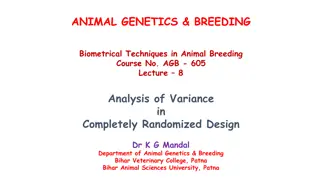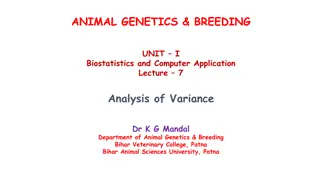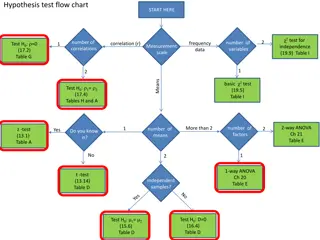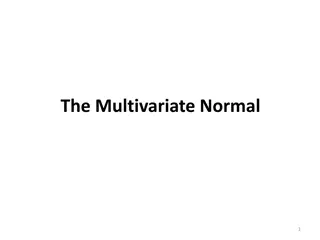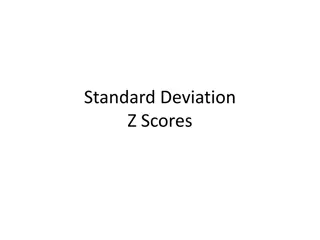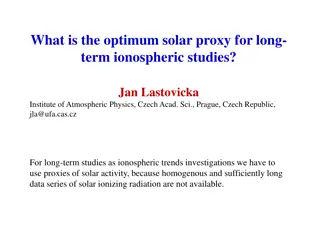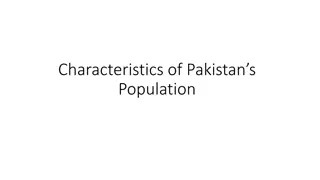Understanding Variance and Its Components in Population Studies
Variance and its components play a crucial role in analyzing the distribution of quantitative traits in populations. By measuring the degree of variation through statistical methods like Measures of Dispersion, researchers can gain insights into the scatterness of values around the mean. Partitioning variance into different components helps identify causes of variation, such as Genotypic Value, Environmental Deviation, and Interaction Effects. Understanding these components is essential for studying phenotypic variance and unraveling the genetic and environmental influences on traits.
Download Presentation

Please find below an Image/Link to download the presentation.
The content on the website is provided AS IS for your information and personal use only. It may not be sold, licensed, or shared on other websites without obtaining consent from the author. Download presentation by click this link. If you encounter any issues during the download, it is possible that the publisher has removed the file from their server.
E N D
Presentation Transcript
Variance and its components Introduction Population recorded on different individuals whether values are same or different. If values are same or similar, then population mean also will be the same. If values are different from individual to individual then population mean cannot tell about the distribution of values around the central value, the population mean. But values of any quantitative trait varies from individual to individual. These differences in values from individual to individual is known as variation. mean gives no idea about the phenotypic values
The degree of variation can be measured with the help of statistical methods known as Measures of Dispersion. Variance is one of the important methods of measures of dispersion to study the scatterness or distribution of values around the mean. The basic idea in the partitioning into different components attributable to different causes. Analysis of variance is the technique which helps in partitioning the total variance into different components attributable to different causes of variation. study of variation is its
What is Variance ? When values population mean, the mean of the squared deviation is known as variance. are expressed as deviation from the variance (s2) = 1/N (xi-x)2 where,x = population mean xi = x1, x2, x3, xN Properties partitioned different causes of variation. of into Variance: different It can components be sub-divided according or to
Phenotypic variance & its components Phenotypic value of an individual depends on its genotypic value and environment in which it is subjected as well as interaction between genotype and phenotype. Thus, P = G + E where, P = Phenotypic value, G = Genotypic value, E = Environmental deviation.
Since, all values are taken as deviation from the population mean, then P = G + E P2= (G + E)2 = G2+E2+2GE where, P = Phenotypic value, G = Genotypic value, E = Environmental deviation. According to definition of variance, VP=VG+VE+2COVGE In absence of interaction between genotype and environment, VP=VG+VE
Components of Genotypic Variance Causes of Genotypic Variation: Breeding Value Dominance Deviation Interaction Deviation G = A + D + I VG = VA + VD + VI Where, VA = Additive genetic variance or variance of Breeding Value VD = Dominance variance or variance due to Dominance Deviation VI = Variance due to non-allelic gene interaction or epistasis (VD + VI) = Non-additive Genetic Variance
Environmental Variance What is Environment? All the non-genetic factors to which an individual is subjected or experienced from the formation of zygote to birth and till death. Evidence of environmental variation: Variation in daily milk yield & Lactation Milk Yield in cow Variation in monthly egg production of poultry Variation in wool production from shearing to shearing Why there is variation? Environmental conditions varies from day to day, time to time, period to period, year to year in spite of best effort of the Farm Manager.
Due to variation in temp., Humidity, cold and heat stress from season to season (seasonal variation), Variation in internal environment, etc. The environmental conditions may be optimum for one animal and may not be sufficient for other animal. An animal with superior genotype may not perform well if received unfavourable environment like poor feeding, poor management and adverse climatic conditions. Such animal cannot exploit its genetic potential to the fullest capacity. Thus, the environmental circumstances leads to variation in genetic expression of the individual on quantitative traits. The environmental variations are not inherited to the progeny.
Classification of Environmental Variations 1. Based on the nature of environmental effects: (a) Tangible variation (b) Intangible variation 2. Based on the time effect of environmental factors i.e., whether the effect of environmental factors is permanent or temporary for a limited time: (a) Permanent environmental effect (b) Temporary environmental effect 3. Based on the nature of variability of environmental factors i.e., variable or fixed: (a) Random or variable environmental effect (b) Non-random or Fixed environmental effect
1. Based on the nature of environmental effects: (a) Tangible variation The Environmental variation arising from recognisable or known causes. Example: (i) Macro environment Different feeding level Different climatic factors Age of the animal Type of management like open vs close housing Management of layer on floor vs battery cage rearing system Weaning practice of calf rearing Different feeding regimen Sex of animal Lactation order or parity These are external causes of environmental variation and are collectively called as macro environment.
(ii) Maternal effects a group of relatives like families or progeny group share common environment. Example: The young are subject to maternal environment during prenatal and postnatal period mainly due to nutrition of mother. The common intra uterine environment of littermates, milk yield and mothering ability of sow also provide a common environment to the piglets. (iii) Error of measurement leads to environmental variation.
(b) Intangible variation : Causes of environmental variation are not known. These causes are called intangible or micro-environment. Example: Variation between monozygotic twins, although they are fed and managed under similar conditions. 2. Based on the time effect of environmental factors i.e., whether the effect of environmental factors is permanent or temporary for a limited time: (a) Permanent environmental effect: Environmental effects which are permanent in nature. Example : Permanent defect or damage of udder due to mastitis. Status of nutrition during calf-hood stage. Training of horses.
(b) Temporary environmental effect : Effect of environment is for a certain period of time. Hence, they are called temporary environmental effects. Example: Feed quality and quantity given. Climatic factors temp., humidity, rainfall, season, etc. Management practices. Notes: i) The permanent and temporary environmental effects can be separated off by partitioning the total phenotypic variance into variance within individuals and variance between individuals.
Ii) Such an analysis of variance is done for the characters which are repeated several times in life time of an individual. These measurements are called multiple measurements. Example : Lactation Milk Yield in dairy animal Shearing of wool in sheep Monthly Egg production in poultry
3. environmental factors i.e., variable or fixed: (a) Random or variable environmental effect Based on the nature of variability of Random or variable environmental effects are those which are not constant for all the individuals but influence the individual records. Random environmental effects affect the individuals not the whole population. They influence the genetic parameters. The significant effect of random variables is reduced as more records are included in average value.
Examlpe: Lameness or infection Hormonal level Sex and age of animal Maternal effect Sire effect Reproductive status of animal (pregnant, lactating) Inbreeding level The important characteristic of random environmental effects is that any individual is equally likely to be affected by a good or bad set of random influences. This means that the best individual will have best genotype.
(b) Non-random or Fixed environmental effect Non-random or fixed environmental effects affect the population as a whole. These are constant for a group of animals. Example: Climate temp., season, humidity, rainfall, sun light, etc. Feeding level quality of feed Management practices Period / year Disease prevalence affect the whole population and the individual as well. These factors influence all the animals of the group / herd.
Components of Environmental Variance In order to partition the variance caused by environmental effects (VE), the classification based on duration of their effect is considered i.e., Permanent environmental effects (Ep) and the temporary environmental effects (Et). The corresponding variance caused by these two categories of environmental effects is termed as permanent environmental variance (VEp) and temporary environmental variance (VEt). The temporary environmental factors affect the individuals for a specific time. Hence, these are called as the special environmental effects and the variation caused by this effect is called special environmental variance. It is denoted by VEs.
The permanent environmental factors affect the phenotypic values in general and hence the variation caused by them is termed as general environmental variance. It is denoted as VEg. Therefore, the environmental variance (VE) is partitioned into two parts as: VE = VEp + VEt = VEg + VEs Hence, the total phenotypic variance can be partitioned into following components: VP = VG + VE = VA + VD + VI + VEg + VEs
Components of Variance __________________________________________________________________________ Variance component Symbol Value whose variance is measured ___________________________________________________________________________ Phenotypic VP VG VA VD VI VE Phenotypic value Genotypic Genotypic value Additive Breeding value Dominance Dominance Deviation Interaction Interaction deviation Environmental Environmental deviation ________________________________________________________
Importance of partitioning of variance Importance of partitioning of variance To estimate the relative importance of various determinants of the phenotype, in particular the role of heredity and environment. To understand the relative importance of each and every component of variance attributable to the different sources of variation. The relative importance of a source of variation is the variance due to that source as a proportion of the total phenotypic variance. To determine genetic determination, VG/VP. To estimate heritability of the character, VA/VP. To determine the degree of resemblance between relatives. For planning the breeding programmes.



